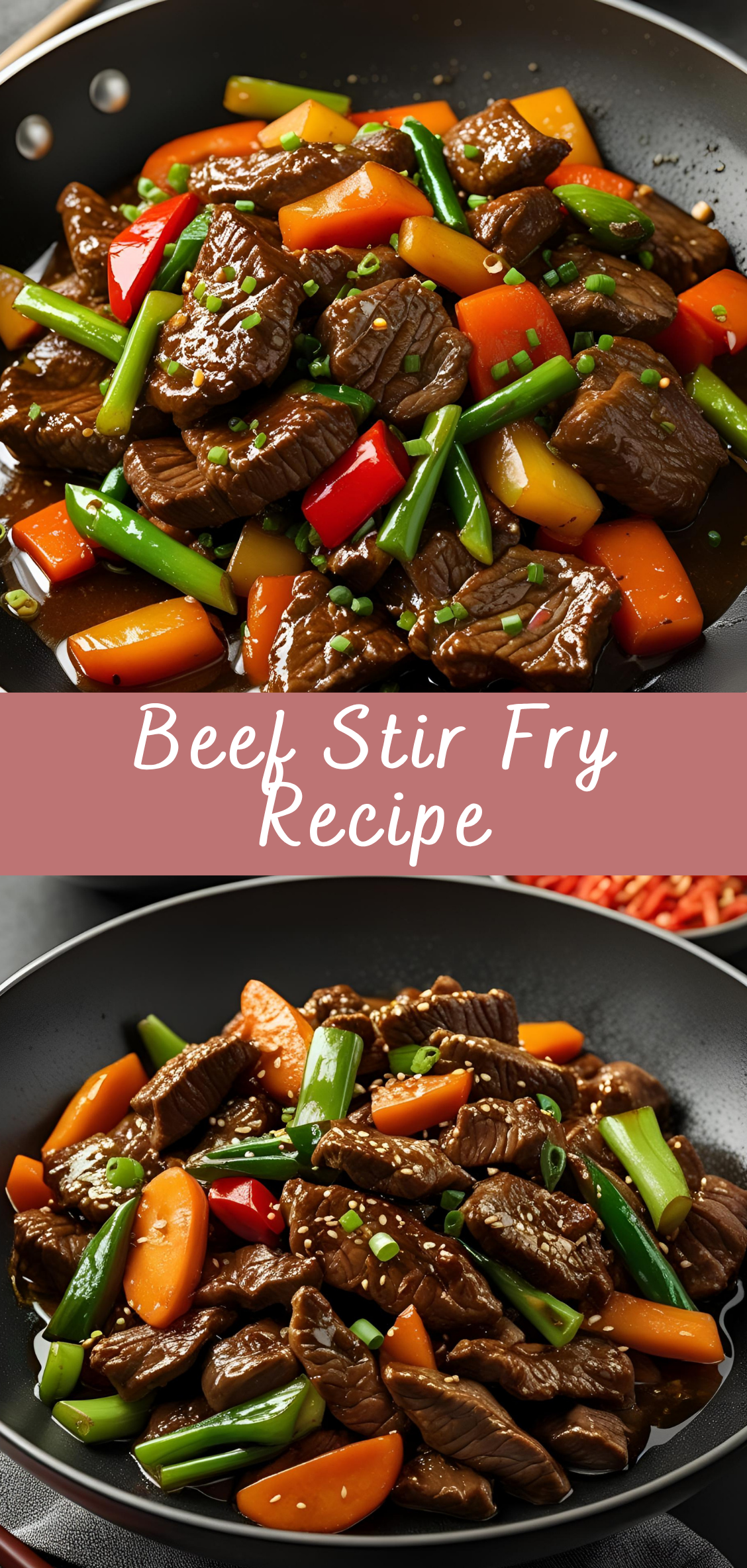Beef Stir Fry Recipe
Stir-frying is a cooking technique deeply rooted in Asian culinary tradition, characterized by its high heat, rapid preparation time, and vibrant flavors. Among the many variations of stir-fry dishes, beef stir-fry stands out as one of the most beloved, appreciated both for its savory taste and its adaptability to different palates and ingredients. This dish, though seemingly simple, holds a remarkable depth in both cultural relevance and culinary technique. The purpose of this recipe is to present a comprehensive guide to preparing a beef stir-fry that balances flavor, texture, and nutrition, while also offering tips and insights to help even beginner cooks feel confident at the stove.

Originating in China, stir-frying was developed as a method to cook food quickly over intense heat, preserving the texture and nutritional content of ingredients while producing a uniquely satisfying flavor profile, often referred to as “wok hei” or the “breath of the wok.” The technique has since spread worldwide, adapting to regional tastes and available ingredients, but its core principles have remained remarkably consistent. Beef stir-fry, in particular, has become a staple in both Asian households and international kitchens, thanks to its combination of protein-rich beef, crisp vegetables, and savory sauces.
What makes beef stir-fry especially appealing is its versatility. It can be tailored to suit dietary restrictions, made with various cuts of beef, and customized using different vegetables and sauces. Whether it’s a weeknight dinner solution or a dish meant to impress guests, a well-executed beef stir-fry brings both comfort and sophistication to the table. The harmony of umami flavors from soy sauce, the mild sweetness of oyster sauce or hoisin, the warmth of garlic and ginger, and the fresh crunch of vegetables creates a dynamic eating experience that is hard to replicate with other methods of cooking.
In today’s fast-paced world, the practicality of a stir-fry cannot be overstated. The ability to bring together a wholesome, satisfying meal in under 30 minutes is a culinary advantage in itself. Yet, the speed of cooking does not compromise the potential for depth in flavor or presentation. With a few essential techniques and an understanding of ingredient interactions, home cooks can elevate a simple beef stir-fry into something restaurant-worthy.
This recipe aims to do more than just list steps—it delves into the why behind each decision, such as choosing the right cut of beef, how to marinate effectively, how to slice vegetables for optimal cooking, and how to layer flavors using a combination of sauces and seasonings. These details are essential to transform a basic stir-fry into an exceptional one.
As we proceed through this guide, each section will provide a deeper exploration of the ingredients, tools, and methods required. From understanding how to achieve the perfect sear on beef slices to mastering sauce proportions and stir-fry timing, the goal is to build a holistic understanding of what makes this dish work. Whether you’re new to cooking or an experienced home chef looking to refine your technique, this recipe will serve as both a detailed instruction manual and an inspiration for creative adaptation.
Ultimately, beef stir-fry represents more than a quick meal—it reflects a philosophy of balance, efficiency, and bold flavor. It captures the essence of culinary craftsmanship with its attention to timing, ingredient integrity, and the beautiful contrast of textures. With this guide, you will not only learn how to cook beef stir-fry, but you’ll also come to appreciate its place in the wider context of world cuisine and everyday eating.
Ingredient Notes and Substitutions
Beef
The choice of beef is critical. Flank steak is widely preferred for stir-frying due to its pronounced beefy flavor and lean texture. It should be sliced thinly across the grain to ensure tenderness. Sirloin and skirt steak are also excellent, especially when properly marinated. For a more luxurious dish, ribeye can be used, offering rich marbling and a buttery mouthfeel, though it requires careful attention to avoid overcooking.
Tip: Partially freezing the beef for about 30 minutes before slicing makes it easier to cut thin, even strips.
Vegetables
Vegetables in a stir-fry are more than just fillers—they bring color, texture, and sweetness to balance the savory beef and sauce. Bell peppers add a crisp bite and natural sweetness, while broccoli and carrots provide both crunch and nutritional density. Snow peas or snap peas contribute freshness and a subtle snap, and mushrooms offer umami depth. Onions and scallions round out the flavor base with their aromatic sweetness and mild sharpness.
Substitutions:
-
Instead of bell peppers: try zucchini, asparagus, or green beans
-
Instead of broccoli: try broccolini, cabbage, or baby bok choy
-
Instead of mushrooms: tofu, eggplant, or even pineapple (for a sweet twist)
Garlic and Ginger
These aromatics form the backbone of flavor in most Asian stir-fries. Fresh is always best, but if unavailable, high-quality garlic paste and ginger paste can substitute in equal amounts. Avoid powdered forms, which lack the brightness and sharpness essential to this dish.
Marinade Ingredients
The marinade tenderizes the beef and infuses it with flavor before cooking. Soy sauce adds salt and umami, Shaoxing wine tenderizes the meat and enhances aroma, cornstarch locks in moisture and aids browning, and sugar balances the savory elements. Baking soda, used sparingly, breaks down proteins and is especially useful for tougher cuts like round steak. Sesame oil adds a nutty fragrance and is best used in small amounts.
Stir-Fry Sauce
This sauce is the heart of the dish, unifying all elements with richness and flavor. While soy sauce provides a salty base, oyster and hoisin sauces build umami and sweetness. Dark soy sauce enhances the dish’s color without making it overly salty. Cornstarch thickens the sauce during cooking, helping it cling to the meat and vegetables. White pepper adds subtle heat without overpowering the dish.
Cooking Oil
Use a neutral oil with a high smoke point to handle the intense heat of stir-frying. Peanut oil is ideal for flavor and temperature resistance. Avoid olive oil, which burns at high temperatures and may add unwanted bitterness.
Beef Stir Fry Recipe
Stir-frying is a cooking technique deeply rooted in Asian culinary tradition, characterized by its high heat, rapid preparation time, and vibrant flavors. Among the many variations of stir-fry dishes, beef stir-fry stands out as one of the most beloved, appreciated both for its savory taste and its adaptability to different palates and ingredients. This dish, though seemingly simple, holds a remarkable depth in both cultural relevance and culinary technique. The purpose of this recipe is to present a comprehensive guide to preparing a beef stir-fry that balances flavor, texture, and nutrition, while also offering tips and insights to help even beginner cooks feel confident at the stove.
Ingredients
- For the Stir Fry:
- 1 lb (450g) flank steak or sirloin, thinly sliced against the grain
- 2 tbsp vegetable oil (divided)
- 2 cups broccoli florets
- 1 red bell pepper, thinly sliced
- 1 carrot, julienned
- 3 cloves garlic, minced
- 1 tsp fresh ginger, grated
- 3 green onions, sliced
- For the Marinade/Sauce:
- 1/4 cup low-sodium soy sauce
- 2 tbsp oyster sauce (optional for deeper flavor)
- 1 tbsp hoisin sauce
- 1 tbsp cornstarch
- 1 tbsp rice vinegar (or white vinegar)
- 1 tbsp brown sugar
- 1/2 tsp sesame oil
- 1/4 cup water or beef broth
Instructions
- Marinate the Beef:
In a bowl, combine soy sauce, oyster sauce, hoisin sauce, cornstarch, vinegar, brown sugar, sesame oil, and water/beef broth.
Add sliced beef to half of the sauce mixture and let it marinate for 10–15 minutes. Reserve the other half of the sauce for cooking. - Cook the Vegetables:
Heat 1 tbsp of oil in a large skillet or wok over medium-high heat.
Add broccoli, bell pepper, and carrot. Stir-fry for 3–4 minutes until slightly tender but still crisp.
Add garlic, ginger, and green onions. Stir for 1 minute. Remove vegetables and set aside. - Cook the Beef:
Add remaining 1 tbsp oil to the pan.
Add marinated beef in a single layer. Sear undisturbed for 1–2 minutes, then stir-fry until browned and just cooked through (about 3–4 minutes). - Combine & Finish:
Return vegetables to the pan.
Pour in reserved sauce. Stir well and cook for another 1–2 minutes, until sauce thickens and everything is coated evenly. - Serve:
Serve hot over steamed rice or noodles. Garnish with sesame seeds or more green onions if desired.
Notes
- Beef Tip: Freeze beef for 15–20 minutes before slicing for easier, thinner cuts.
- Vegetable Options: Snow peas, mushrooms, or zucchini work well too.
- Spice It Up: Add chili flakes or sriracha to the sauce for a spicy kick.
- Gluten-Free: Use tamari or a gluten-free soy sauce substitute.



